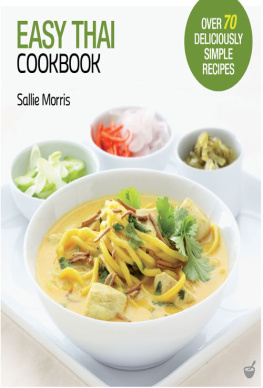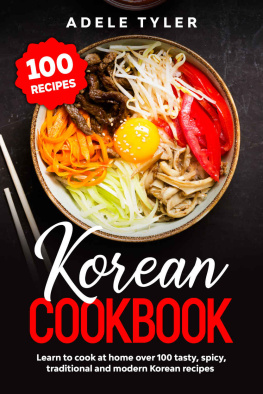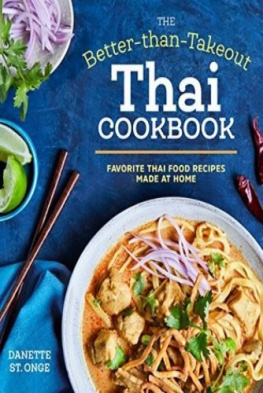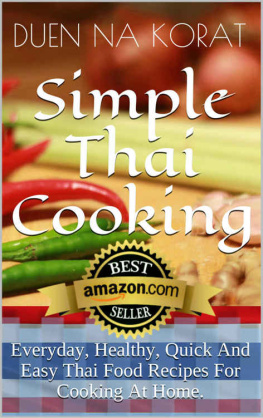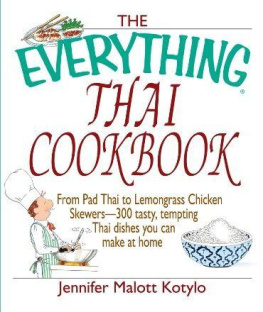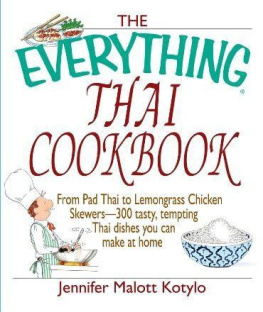THAI
COOKBOOK
70 Easy Recipes For Stir Fry Noodles Tom Yum And Traditional Dishes From Thailand |
Emma Yang
Copyright 2021 by (Emma Yang) - All rights reserved.
This document is geared towards providing exact and reliable information in regards to the topic and issue covered. The publication is sold with the idea that the publisher is not required to render accounting, officially permitted, or otherwise, qualified services. If advice is necessary, legal or professional, a practiced individual in the profession should be ordered.
- From a Declaration of Principles which was accepted and approved equally by a Committee of the American Bar Association and a Committee of Publishers and Associations.
It is not legal in any way to reproduce, duplicate, or transmit any part of this document in either electronic means or in printed format. Recording of this publication is strictly prohibited and any storage of this document is not allowed unless with written permission from the publisher. All rights reserved.
The information provided herein is stated to be truthful and consistent, in that any liability, in terms of inattention or otherwise, by any usage or abuse of any policies, processes, or directions contained within is the solitary and utter responsibility of the recipient reader. Under no circumstances will any legal responsibility or blame be held against the publisher for any reparation, damages, or monetary loss due to the information herein, either directly or indirectly.
Respective authors own all copyrights not held by the publisher.
The information herein is offered for informational purposes solely, and is universal as so. The presentation of the information is without contract or any type of guarantee assurance.
The trademarks that are used are without any consent, and the publication of the trademark is without permission or backing by the trademark owner. All trademarks and brands within this book are for clarifying purposes only and are the owned by the owners themselves, not affiliated with this document.
Contents
Introduction
Never despair if you have not figured out a way to go on an adventurous backpacking trip across Thailand. In the comfort of home, you can taste a true Thai experience worthy of your taste buds. There's no going back once you've discovered the flavors of Thai food.
Thai cuisine is well-known in the world. This one-of-a-kind cuisine is a fusion of East and West impacts dating back centuries. Harmony is an essential component of any dish. For Thai food to be genuine, the flavors and spices must be mixed cooperatively. The key characteristic of Thai cuisine is that each food should contain four basic flavors: sweet, spicy, salty, and sour . Chilies provide the heat, while sugar or fruit sugar provides the flavor. The alkalinity arises from star anise or lemon slices, whereas the salt concentration comes from sesame oil, shrimp paste, or fish sauce, among other things. Vegans can check with the diner to see whether any vegetable dishes include a fish sauce or seafood paste.
Various areas of Thailand and specific chefs can favor one of the four senses over the others, which is why a set of seasonings, such as salt, seafood or soy sauce, mustard, and dry or new chili, is often placed on the table in Thailand . As a result, the diner will change the balance to his or her preference. So, if you are served a meal that's still not really to your liking, such as one that's not hot enough, you can change the seasonings.
Savory, honey, sour, salty, and spice are the five main flavors in a typical Thai meal. Many Thai dishes are not considered complete unless they include all five. Although the seasoning may be hot for a western palate, Thai cuisine assures that all flavors are balanced. A community of Thai diners will enjoy a handful of beef and fish dishes, as well as veggies, a pasta dish, and probably soup while dining out or preparing a meal at home . Except for the soup, which each person can request, or each person receives a private bowl to receive a portion of the stew, everything is distributed. Fresh fruit, like mango or any of the hundreds of exotic fruits found throughout the world, can be served as a sweet. It may also be more creative, such as colorful rice cakes, tamarind chutney dumplings, fruit jelly, or a bean cake.
With these extinct flavors, "Thai Cookbook" has a wide range of delicious Thai recipes. It has five chapters with appetizers, snacks, breakfast, lunch, dinner, desserts, and Thais most famous recipes. Read this book, follow these recipes, and have a flavorful, delicious meal every day.
Chapter 1: Introduction to Thai Cuisine
Food is an important part of every social gathering in Thailand, and it is often used as a social event or a reason to be happy. This is partly due to Thai people's pleasant, peaceful nature, but it's also simply because of how food is prepared, consumed, and enjoyed. Food brings people together and allows them to bond.
1.1 History of Thai Cuisine
The flavors of modern-day Thailand have their origins in ancient culture. The Thai people developed what is now known as the core of Siamese delicacies: different types of meat and fish coupled with rice, local veggies, spices, and aromatic citrus and chili as early as the 12th century. After, the Chinese brought pasta and the most popular Thai cooking weapon, the steel skillet, to Thailand.
Thai cuisine is strongly influenced by Traditional spices and flavors, as evidenced by the country's popular green, orange, and yellow curries. Thai curries are difficult to compare with Indian curries because they use several Indian spices in their seasonings while still retaining their distinct flavors thanks to locally sourced ingredients like Thai essential oils, rosemary, and galangal.
Other neighboring countries, such as Vietnam, Indonesia, Cambodia, Laos, Myanmar, and Malaysia, have influenced Thai cuisine. The nuanced flavor of modern Thai cookingone of the fastest production and most famous cuisinesis the product of many diverse influences.
1.2 Traditional History of Thai Dishes
Thais avoided using large animals in large pieces because of their Buddhist heritage. Shredded large cuts of beef were seasoned with spices and herbs. Thai traditional recipes included stewing, cooking, and roasting. Roasting, stir-frying, and intense were all introduced as a result of Chinese trends. From the 17th and 18th centuries onwards, Dutch, Portuguese, English, and Japanese cuisines influenced the cuisine. Chilies were first exposed to Thai cuisine by Portuguese priests in the late 1600s, who had developed a taste for them while working in South America.
Rice is one of the most important ingredients in Thai cuisine. Rice is by far the most often served food at all dinners, and it is never discarded. Thailand produces and serves a wide range of rice cultivars, with Jasmine being the most common and the most costly. White rice is plentiful and less costly than Jasmine rice while being still tasty. Glutinous, or steamed rice, is also fairly popular, and brown bread is abundant and less costly than Jasmine rice while being still yummy. Another significant feature of Thai culture is the formal presentation of meals. The dining experience is influenced by attention to detail and how appealing it appears when served.
Irrespective of the delicious flavors, the dish must be visually pleasing, and this feature respects Thai culture's reverence for its food items. Even though the Chinese introduced utensils to Thailand many years ago, most Thais tend to use Western knives and forks in their unique way. A fork and a big spoon are the most popular pieces of Thai cutlery. The fork helps organize the foods on the spoon before taking it to the mouth, and the teaspoon is kept in the right wrist and is used in replacement of a knife. There is no need for a blade since all of the dishes are already sliced up.


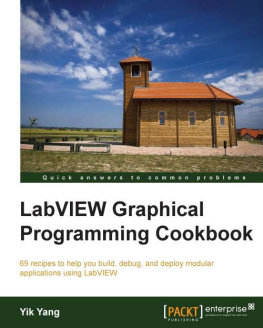

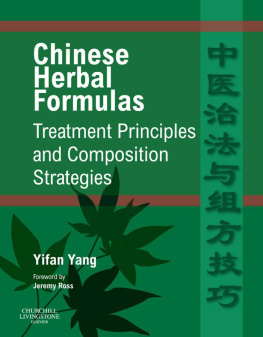
![Yang - The latehomecomer: [a Hmong family memoir]](/uploads/posts/book/165016/thumbs/yang-the-latehomecomer-a-hmong-family-memoir.jpg)


